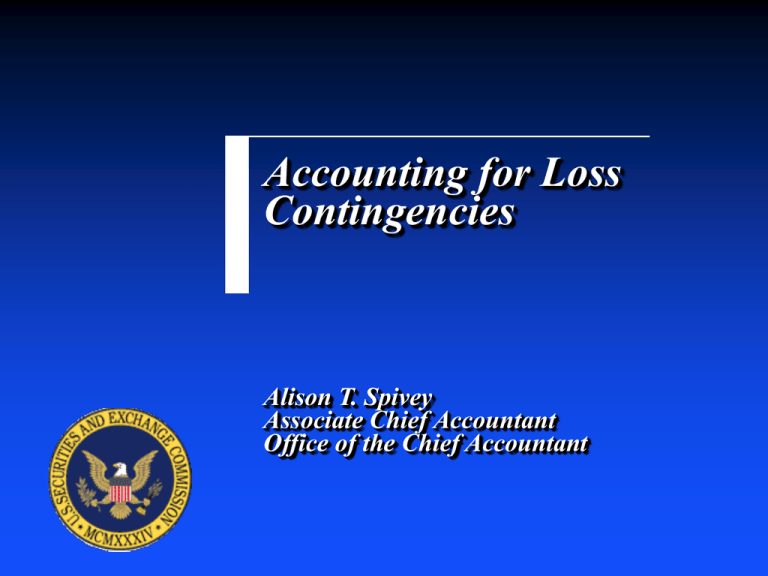Accounting for Loss Contingencies Alison T. Spivey Associate Chief Accountant
advertisement

Accounting for Loss Contingencies Alison T. Spivey Associate Chief Accountant Office of the Chief Accountant Disclaimer The Securities and Exchange Commission, as a matter of policy, disclaims responsibility for any private publication or statement by any of its employees. Therefore, the views expressed today are my own, and do not necessarily reflect the views of the Commission or the other members of the staff of the Commission. 2 Presentation overview •Use of estimates in financial statements •Accounting for loss contingencies •SEC views •Assumptions used in accounting estimates •The role of disclosures •Recent activities in OCA •Consulting with OCA staff 3 Use of Estimates •Financial statements include estimates of underlying values of assets, liabilities, and equity Financial instruments Contingencies Compensation programs (e.g., stock options) •Current accounting standards provide guidance on preparing estimates. 4 Loss Contingencies - Current Accounting Model •Statement 5 issued in 1975. •Requires accrual of estimated loss from loss contingency Probable Reasonably estimable •Disclosure of estimated possible loss or range of loss required when accruals not recorded. 5 Recent Accounting Standards and Other Guidance •Statement 143 – Asset Retirement Obligations •Statement 146 – Exit or Disposal Activities •FIN 45 – Guarantees •Concept Statement 7 – Cash Flow Information and Present Value Measurements 6 Proposal Stage Literature •FASB: Fair Value Measurements Business Combinations Conceptual Framework •IASB: Business Combinations Provisions and Contingent Liabilities 7 Loss Contingencies - Commissioner and Staff Views •1998 – Chairman Arthur Levitt, The “Numbers” Game •Staff Accounting Bulletins •Recent staff speeches 8 Assumptions •Assumptions underlying accounting estimates – guidance in specific accounting standards Pension accounting Share-based payment (stock options) •Staff Accounting Bulletin 107 9 Disclosures •Financial statements •MD&A •Critical Accounting Estimates 10 Study and Report on Off-Balance Sheet Arrangements Overview Mandated by Section 401(c) of Sarbanes-Oxley Extent of off-balance sheet transactions, including the extent to which SPEs are used to facilitate such transactions Assessment of GAAP and Commission rules in providing transparency of such transactions to investors Assessment of GAAP consolidation of SPEs by sponsors who have majority of risks and rewards 11 Study and Report on Off-Balance Sheet Arrangements Topics Addressed Leases Retirement arrangements Consolidation issues Contingencies Transfers of financial assets with continuing involvement 12 Study and Report on Off-Balance Sheet Arrangements Improvements to Financial Reporting Discourage transactions and transaction structures motivated by accounting and reporting considerations Expand use of objectives-oriented standards Improve consistency and relevance of disclosures Focus financial reporting on communication with investors, rather than just rule compliance 13 Share-Based Payment Market Instruments A market instrument is an instrument that is designed to be sold into the market at a value intended to be reasonably equivalent to the fair value of employee share options. A statement providing the former Chief Accountant’s views on market instruments available at http://www.sec.gov/news/speech/spch090905dtn.htm Chairman Cox’s statement available at http://www.sec.gov/news/press/2005-129.htm 14 Insurance Risk Transfer Not only an issue for insurance companies To ensure appropriate accounting for insurance contracts under FAS 5, noninsurance companies need to assess whether the contract indemnifies the company against loss AICPA Technical Practice Aid, Accounting by Noninsurance Enterprises for Property and Casualty Insurance Arrangements That Limit Risk 15 Valuation Issues MEASUREMENT: Valuations must be in accordance with appropriate U.S. GAAP standards and related guidance Reliability of measurement Not looking for precise measurements Reasonable range of estimate based upon available information Use of “Concepts 7” approach Very rare to use risk free discount rate Materiality assessment cannot be made unless try to do some analysis calculation 16 Valuation Issues SFAS 141 – immaterial items may collectively materially misstate goodwill SFAS 123 – very rare that option is so complex that unable to value using option pricing models USE OF EXPERTS: Valuator’s role: independent/unbiased valuations Whether prepared by management or use of outside experts “Indication of value” level of assurance is not sufficient if primary valuation evidence Management is responsible for valuation assumptions in SEC filings Any reference to valuator raises valuator expertization issues in SEC filings 17 Consultations with OCA Guidance for Consulting with OCA Most companies just “want to get the accounting right.” We want to help. Guidance for resolving ‘pre-filing’ questions is posted on the SEC’s website http://www.sec.gov/info/accountants/ocasubguidance.htm Companies should provide OCA with a written submission (commonly referred to as a “pre-clearance” submission) Auditor participation is required Registrants can request their SEC reviewer to consult on specific matters during a Corp. Fin review process 18 Consultations with OCA Consulting with OCA Recommended form and content of correspondence to expedite the process What to expect from OCA Team leader will contact the company within 3 days of receipt of submission; entire process usually takes 2 – 4 weeks but depends on nature of the issue Team, Senior Associate and Deputy Chief Accountants may be involved Company may request Chief Accountant review of conclusion reached by OCA staff 19

